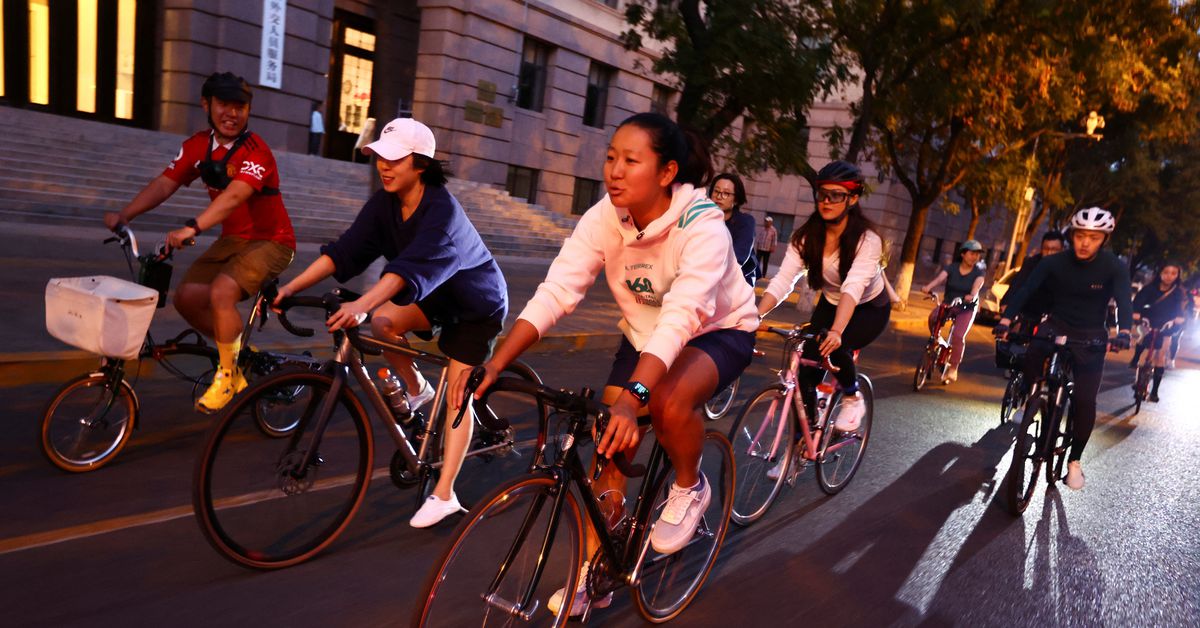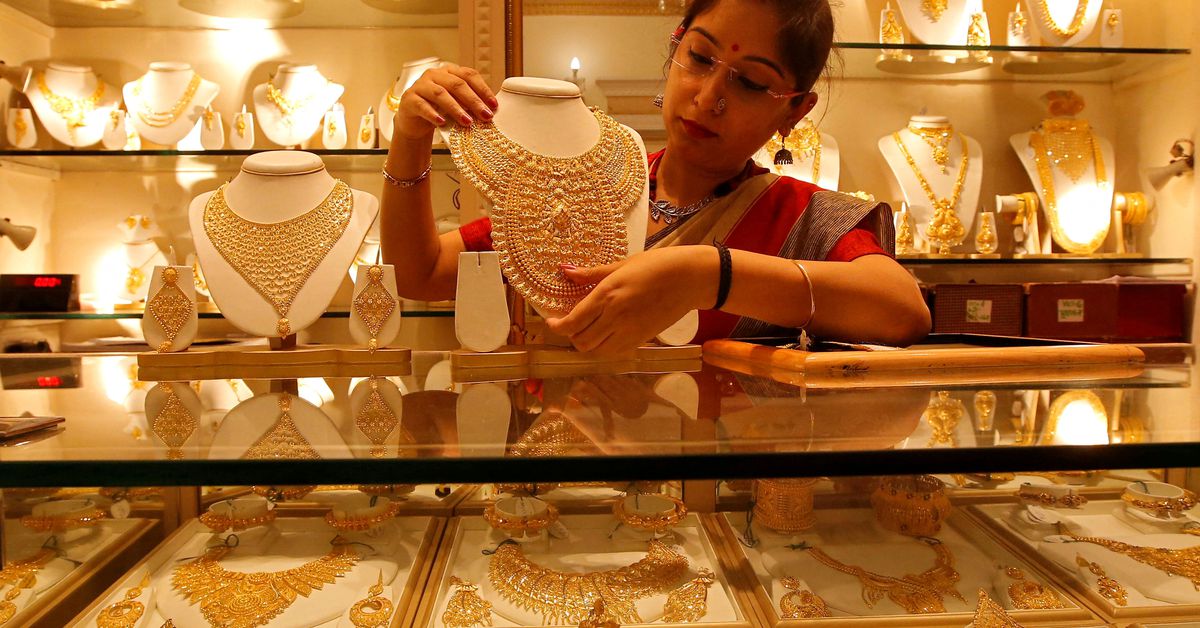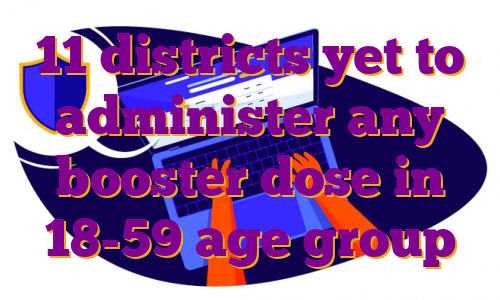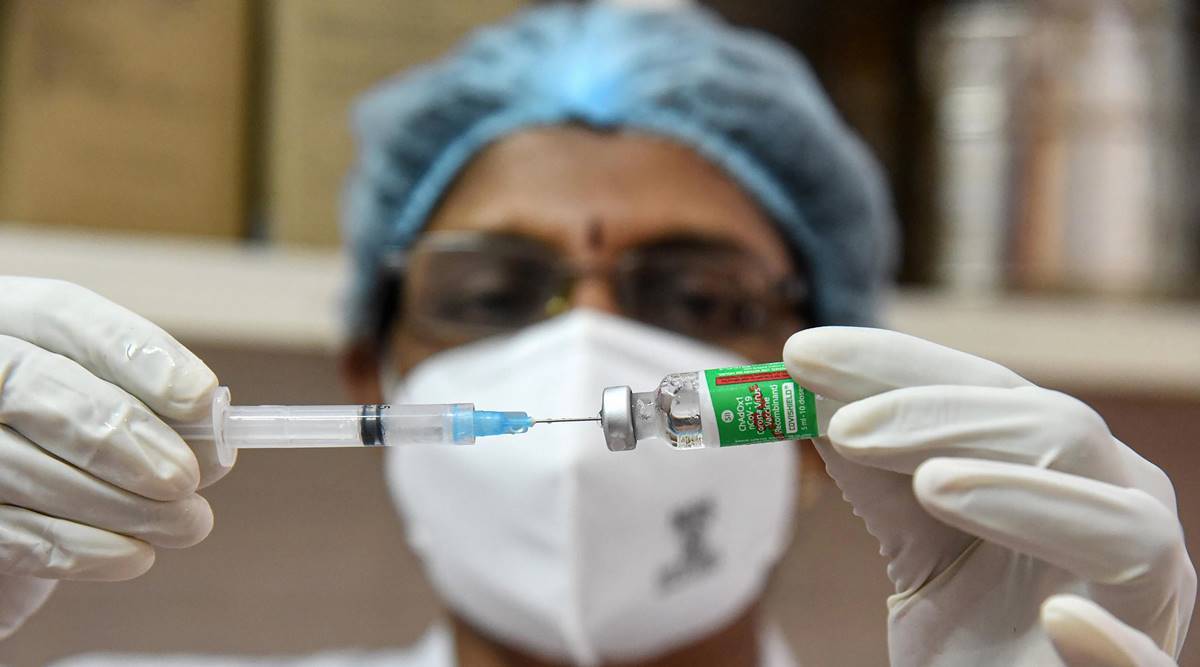Register now for FREE unlimited access to Reuters.comBEIJING, Sept 13 (Reuters) – Zhou Changchang likes to spend his spare time cruising along the streets of China’s capital with his cycling club friends, on his Tiffany Blue bicycle made by the British company Brompton.The 42-year-old teacher is part of a growing army of cycling enthusiasts in China, who are splashing out on premium bicycles made by the likes of Brompton, Giant and Specialized, fuelling a market that consultancy Research & Markets estimates could be worth $16.5 billion by 2026.Social media and e-commerce platforms say there has been a surge of interest in cycling over the past year and sales of bicycles and gear are booming.Register now for FREE unlimited access to Reuters.comTypically, Chinese cyclists will pay more than 13,000 yuan ($1,870) for an inner-city, high-end foldable bike made by the likes of Brompton. High-performance road bikes, made for longer journeys, start at around 10,000 yuan ($1,450) and can go many times higher.Last month, media reported that a bicycle made by luxury brand Hermes sold for 165,000 yuan ($24,500).”The majority of riding hobbyists are willing to splurge,” e-commerce platform JD.com said last month.It said road bike sales on its platform had more than doubled from June to August compared with the same time last year, while riding apparel sales had jumped 160%.China has had a long love affair with bicycles and was once known as the “kingdom of bicycles”.For decades, bikes made by the likes of the Flying Pigeon company filled the streets.Cycling fell out of fashion when a growing middle class turned to cars but bike manufacturers saw a revival in 2014 as bike-sharing companies like Mobike and Ofo sprang up to flood cities with their fleets, offering rides as cheap as 1 yuan.Zhou, like many cyclists, said he got into biking to get fit. COVID-19 and its lockdowns also created a urge for the open road.”I really longed for the outdoors and fresh air,” said Shanghai office worker Lily Lu who went out and ordered a Brompton bike for 13,600 yuan ($1,965) the day after she was released from a three-month lockdown.As the craze gathers pace, manufacturers are struggling to meet demand. Lu said she had to wait two months to get her bicycle. Brompton did not respond to a request for comment.China’s Pardus, which makes racing bikes that can cost more than 30,000 yuan ($4,335), said sales doubled from last year and its factory was operating around the clock.”Everything is out of stock,” said Pardus branding director Li Weihai.
($1=6.96 yuan)Register now for FREE unlimited access to Reuters.comReporting by Sophie Yu, Brenda Goh; Editing by Robert BirselOur Standards: The Thomson Reuters Trust Principles. .
Surrendering a policy: When should you do it — and should you at all?
As the pandemic hit lives, the economy, and livelihoods, 2021-22 witnessed a sharp spike in insurance policies being surrendered ahead of their maturity. Data show that more than 2.3 crore life insurance policies were surrendered during the year — more than three times the number of policies (69.78 lakh) surrendered in 2020-21.
It is ironical that at a time when one is in desperate need of his/ her money, while surrendering a traditional policy (endowment or money back), policyholders in the majority of cases end up with a surrender value that is even lower than the premiums paid.
In case of unit-linked plans, it may result in lower returns on the capital investment. It is, therefore, very important to understand the pitfalls of surrendering, and to evaluate all options before you decide to do so.
What should you look for before surrendering your policy?
The first thing that one needs to check is the surrender value. “Often, people don’t check the surrender value, and assume that the current value of the policy is what they will get if they surrender. It is only later that they realise that what they have received is much less than the current value. So one must check the surrender value before taking the decision,” said Surya Bhatia, founder, AM Unicorn Professional.
Advisers say that policyholders must also evaluate the reason for surrendering the policy, and the various options they can explore with insurance companies. Individuals must look at the reason for surrender — whether they need the money or they think they can’t make future premium payments — and accordingly make their decision.
If one is looking to surrender the policy because they believe they can’t pay future premiums, the policyholder must reconsider.
“After you finish with the minimum period of paying premiums, you have the option to either surrender or stop paying further premiums. Very often this is referred to as paid-up status, where you stop paying the premium and the benefits of your policy reduce proportionately in line with the reduced payment period, Vishal Dhawan, founder, Plan Ahead Wealth Advisors, said.
“So,” he said, “if someone needs to control future cash flows, the individual must explore the paid-up option. Many a time, paid-up options are not looked at by people, and they think that they can either continue or surrender.”
If one is in need of money, one can consider taking a loan against the policy, if the requirement is for a temporary period.
In cases where one is looking to surrender the policy to avoid risk of asset class (volatility in equity markets) in case of Ulips, one has the option to move the money from equity underlying fund to something that is debt-oriented.
Newsletter | Click to get the day’s best explainers in your inbox
What are the impacts of surrendering a policy?
There are several pitfalls, including losing the insurance cover linked to the policy.
The biggest impact that premature surrendering has is on the return you get out of the policy, as surrender value is much less than what you can get on maturity.
There is no standard answer as to what a surrender value can be — it depends upon the kind of policy (traditional or unit linked), years of premium paid, and term of the policy.
Financial experts say that in case of money-back, endowment, and whole life plans, individuals suffer big losses on account of surrendering the policy and can lose around 50 per cent of the premium paid.
In case of Ulips, since they can’t be surrendered till the fifth year and can only be done at the end of the sixth year, experts say that there is not much loss. However, it does impact the return for the investors because of early termination of the policy.
Another impact is on the aspect of taxation. “People often miss the fact that while the policy is tax-free at maturity, if you surrender ahead of maturity, you miss out on that as it attracts tax at the marginal tax rate applicable to the individual policyholder,” Bhatia said.
Should you surrender your policy at all?
As the drawbacks of surrendering are many, financial advisers suggest that it should be one of the last options. It is advisable that when in need of money, investors should carefully look at their entire investment corpus — mutual funds, insurance policy, fixed deposits, bonds, etc. — and after understanding the implications of giving up each of them, they should figure out which one should go first, and which should be taken up last.
“When you explore all the options and take a measured approach, you will end up taking a better decision, Dhawan said. He added that “while one can still do it with investment policies, it is crucial that one doesn’t do it with term policies”.
Bhatia said that surrendering a policy should be the last resort. “Explore other options. Only in the case of Ulip plans, if the policy is not working according to the plan, you may look to surrender — but that too to reinvest in a better performing policy or other financial instrument,” he said.
!function(f,b,e,v,n,t,s)
{if(f.fbq)return;n=f.fbq=function(){n.callMethod?
n.callMethod.apply(n,arguments):n.queue.push(arguments)};
if(!f._fbq)f._fbq=n;n.push=n;n.loaded=!0;n.version=’2.0′;
n.queue=[];t=b.createElement(e);t.async=!0;
t.src=v;s=b.getElementsByTagName(e)[0];
s.parentNode.insertBefore(t,s)}(window, document,’script’,
‘https://connect.facebook.net/en_US/fbevents.js’);
fbq(‘init’, ‘444470064056909’);
fbq(‘track’, ‘PageView’);
.
Asia Gold High prices drag India discounts to 7-week low; China demand sluggish
A saleswoman displays a gold necklace inside a jewellery showroom on the occasion of Akshaya Tritiya, a major gold buying festival, in Kolkata, India, May 7, 2019. REUTERS/Rupak De ChowdhuriRegister now for FREE unlimited access to Reuters.com
- India sees discount of up to $10/oz vs $9 last week
- Indian buyers will wait for a hefty correction- dealer
- Buyers in China cautious, conserving their expenditure – analyst
June 10 (Reuters) – Gold discounts in India this week were stretched to their highest level in seven weeks as higher prices repelled demand, while fresh concerns over the spread of COVID in top-consumer China left buyers reluctant to make purchases.This week, dealers in India were offering a discount of up to $10 an ounce over official domestic prices — inclusive of the 10.75% import and 3% sales levies, up from the last week’s discount of $9.Retail buying in India will remain weak, especially from rural areas as farmers focus on planting of summer-sown crops, said a Mumbai-based dealer with a private bullion importing bank.Register now for FREE unlimited access to Reuters.com“In May, prices were attractive. Retail consumers were buying for weddings. Now buyers will wait for a hefty correction,” the dealer said.Weddings are one of the biggest drivers of gold purchases in India.In China, gold was being sold at a discount of $1.5 to a premium of $0.5 an ounce versus global benchmark spot rates .Physical gold demand in China is pretty sluggish, StoneX analyst Rhona O’Connell said, adding that people haven’t been coming back into the market yet after lockdowns were eased, as they are cautious about the outlook and are conserving their expenditure for now.China’s commercial hub of Shanghai faces an unexpected round of mass COVID-19 testing for most residents this weekend – just 10 days after a city-wide lockdown was lifted. read more COVID-related restrictions weighed on demand in China in May and “the average trading volumes of Au9999 – a proxy of Chinese wholesale gold demand – witnessed the weakest May since 2013,” the World Gold Council said in a monthly note.In Hong Kong, gold continued to be sold at a discount of about $1.8 an ounce to a $1 premium, while in Japan, gold was sold between a premium of 50 cents and at par with the benchmark.Register now for FREE unlimited access to Reuters.comReporting by Eileen Soreng, Bharat Govind Gautam in Bengaluru, Rajendra Jhadav in Mumbai; Editing by Shailesh KuberOur Standards: The Thomson Reuters Trust Principles. .
11 districts yet to administer any booster dose in 18-59 age group
ALMOST TWO months after booster shots were allowed for the population between 18-59 years, 11 districts — Akola, Bhandara, Parbhani, Gadchiroli, Gondia, Hingoli, Nanded, Sindhudurg, Wardha, Washim and Yavatmal — haven’t administered a single dose in the concerned age group.
There are eight districts that have administered less than 50 booster shots. This also includes Health Minister Rajesh Tope’s district Jalna, which as of June 1, had administered only three shots.
As per official data till June 1, only 2.68 lakh beneficiaries in the 18-59 age group have taken the first dose in the state. Among them, 96 per cent doses have been administered in seven districts.
A total of 1.19 lakh have taken the third shot in Mumbai, followed by Pune (61,075), Thane (49,389), Raigad (10,151), Aurangabad (6,399), Nagpur (5,601) and Nashik (5,490).Best of Express Premium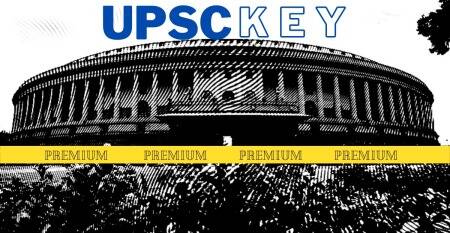 Premium
Premium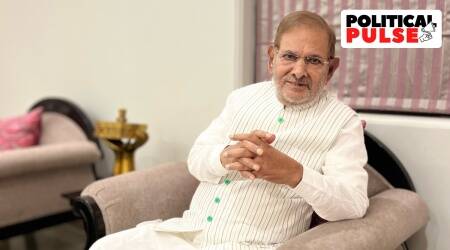 Premium
Premium Premium
Premium Premium
Premium
🚨 Limited Time Offer | Express Premium with ad-lite for just Rs 2/ day 👉🏽 Click here to subscribe 🚨
The most affected ones are from rural areas where people have to travel a long distance to reach cities to get the third shot.
A 42-year-old woman living with HIV had to travel 50 km to get the third shot in Nagpur from the Mohadi taluka in Bhandara. “We couldn’t find a single private centre administering booster shots. Due to infection, we have to be extra cautious so we decided to travel to Nagpur,” she said.
This is not an isolated case. Many patients with underlying health issues that make them more vulnerable to contracting Covid-19 are being forced to travel to cities for the booster shot.
Booster doses for frontline workers and people above 60 years were started on January 10. On April 10, the facility was extended to the 18-59 age group. However, with the flattening of the pandemic curve, the demand for the third shot dropped, which discouraged the private sector from stocking the vaccines.
According to Indian Medical Association (IMA), over five lakh expired vials were discarded in Maharashtra till May. This deterred many private centres, especially in the rural parts, from carrying out vaccination drives.
Dr Avinash Bhondwe, former president of IMA, Maharashtra, said that at the beginning of the immunisation programme in 2021, private hospitals had to buy vials in bulk at high rates. Later, when the demand for vaccination dropped, their stocks expired. “It caused huge economic loss, especially for the smaller private hospitals. So, now they don’t want to buy the vaccines risking further loss,” he said.
“We are merely following the protocols laid by the Centre. As soon as we get a new instruction, we will start free vaccination in public places,” said Dr Pradeep Vyas, Additional Chief Secretary.
Public health experts have highlighted the need to make the third shot accessible to all free of cost. “The booster shots will not prevent infection but as seen in the past, the vaccination helps to control the severity among patients. So, it is essential that the people especially the elderly above 50 years old and patients with comorbidities take the third jab,” said Dr Bhondwe.
Dr Subhas Salunke, a technical advisor to the state government, said that in a pandemic situation, the Centre should supply the vaccines free of cost. “There are lakhs of people, who can’t even afford to buy the vaccines..”
The official figures also found a lukewarm response to free booster shots among the eligible population above 60 years. As of June 1, 16.44 lakh elderly in the age group have taken the third shot. Nearly 68 per cent of the eligible healthcare and frontline workers haven’t taken the precautionary dose in the state, the data revealed.
Dr Sachin Desai, state immunisation officer, cited several reasons behind the poor response like laxity and less fear of contracting the infection with a drop in Covid-19 cases. “Some beneficiaries had developed minor reactions like fever and body pain after taking the first or second doses. So, fearing it, most of the villagers are shying away from it now,” he said.
The state has over 1.3 crore vaccines in stock. “Now, we have an abundance of vaccines but the demand is low. Even after repeated alerts, 90 per cent of the people don’t show up. So, we have started a door-to-door survey,” said Dr Govind Chaudhari, District Health Officer, Nandurbar.
!function(f,b,e,v,n,t,s)
{if(f.fbq)return;n=f.fbq=function(){n.callMethod?
n.callMethod.apply(n,arguments):n.queue.push(arguments)};
if(!f._fbq)f._fbq=n;n.push=n;n.loaded=!0;n.version=’2.0′;
n.queue=[];t=b.createElement(e);t.async=!0;
t.src=v;s=b.getElementsByTagName(e)[0];
s.parentNode.insertBefore(t,s)}(window, document,’script’,
‘https://connect.facebook.net/en_US/fbevents.js’);
fbq(‘init’, ‘444470064056909’);
fbq(‘track’, ‘PageView’);
.
Shift to premium spirits helps Remy weather China lockdowns
- 2021/22 current operating profit up 39.9% vs forecast 38.6%
- Expects another year of strong growth in 2022/23
- Still eyes double-digit organic sales growth in Q1 – CEO
PARIS, June 2 (Reuters) – France’s Remy Cointreau (RCOP.PA) on Thursday predicted a strong start to its new financial year, as broad demand for its premium spirits helps to offset inflationary pressures and the impact of COVID lockdowns in China.The maker of Remy Martin cognac and Cointreau liquor made the upbeat comments after reporting higher-than-expected operating profit growth for its financial year ended March 31.”On the strength of our progress against our strategic goals, new consumption trends and our robust pricing power, we are starting the year 2022-23 with confidence,” Chief Executive Officer Eric Vallat said in a statement.Register now for FREE unlimited access to Reuters.comThe pandemic has helped Remy’s long-term drive towards higher-priced spirits to boost profit margins, accelerating a shift towards premium drinks, at-home consumption, cocktails and e-commerce.Vallat told journalists that for the new fiscal year, Remy expected “solid profitable growth” as price increases and cost control would help mitigate inflationary pressures.In the short term, Vallat said: “I can confirm we are expecting double-digit organic sales growth in the first quarter despite the lockdown in China and high comparables.”With China accounting for 15-20% of group sales, growth would be led by demand from other regions, notably the United States.Strong demand for its premium cognac in China and the United States, along with tight cost management, lifted the company’s 2021/22 organic operating profit by 39.9% to 334.4 million euros ($356.3 million), beating the 38.6% forecast by analysts.Reflecting its confidence, Remy said it would pay shareholders an ordinary dividend of 1.85 euros per share in cash and an exceptional dividend of 1 euro.”Remy guides to another year of strong growth and margin improvement, led by its strong pricing power, which suggests upside to consensus organic EBIT of +10%,” Credit Suisse analysts said in a note.Remy Cointreau shares jumped more than 3% in early trade, before handing back some gains.The company reiterated its 2030 goals for a gross margin of 72% and an operating margin of 33%. That compares with the 68.6% and 25.5% achieved respectively in 2021/22.($1 = 0.9385 euros)Register now for FREE unlimited access to Reuters.comReporting by Dominique Vidalon Editing by Sherry Jacob-Phillips and Mark PotterOur Standards: The Thomson Reuters Trust Principles. .


